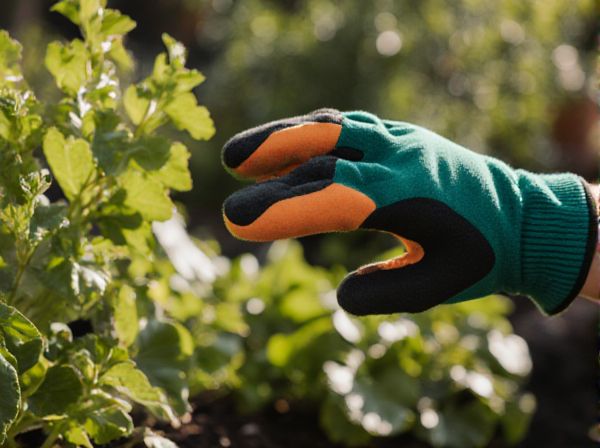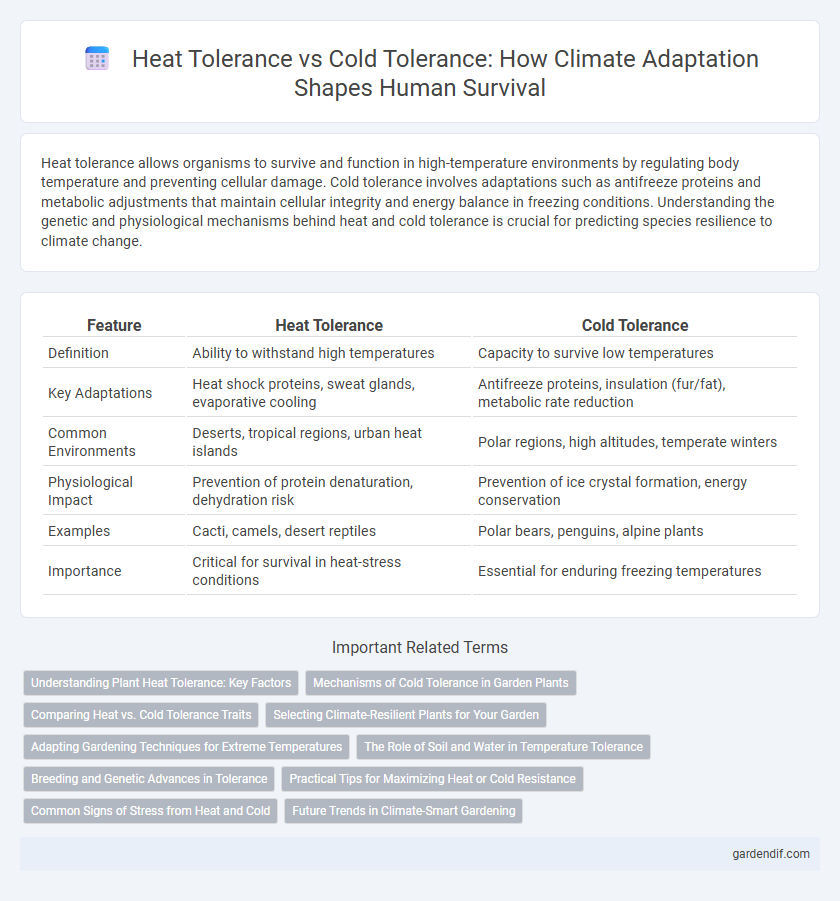
Heat tolerance vs Cold tolerance Illustration
Heat tolerance allows organisms to survive and function in high-temperature environments by regulating body temperature and preventing cellular damage. Cold tolerance involves adaptations such as antifreeze proteins and metabolic adjustments that maintain cellular integrity and energy balance in freezing conditions. Understanding the genetic and physiological mechanisms behind heat and cold tolerance is crucial for predicting species resilience to climate change.
Table of Comparison
| Feature | Heat Tolerance | Cold Tolerance |
|---|---|---|
| Definition | Ability to withstand high temperatures | Capacity to survive low temperatures |
| Key Adaptations | Heat shock proteins, sweat glands, evaporative cooling | Antifreeze proteins, insulation (fur/fat), metabolic rate reduction |
| Common Environments | Deserts, tropical regions, urban heat islands | Polar regions, high altitudes, temperate winters |
| Physiological Impact | Prevention of protein denaturation, dehydration risk | Prevention of ice crystal formation, energy conservation |
| Examples | Cacti, camels, desert reptiles | Polar bears, penguins, alpine plants |
| Importance | Critical for survival in heat-stress conditions | Essential for enduring freezing temperatures |
Understanding Plant Heat Tolerance: Key Factors
Plant heat tolerance depends on physiological traits such as efficient transpiration, heat shock protein production, and membrane stability under high temperatures. Genetic factors play a crucial role in enabling plants to maintain photosynthesis and cellular function during heat stress. Understanding these mechanisms helps in developing crop varieties resilient to increasing global temperatures.
Mechanisms of Cold Tolerance in Garden Plants
Garden plants survive cold temperatures through mechanisms such as antifreeze protein production, which inhibits ice crystal formation within cells, maintaining cellular integrity. The accumulation of osmoprotectants like proline and sugars stabilizes cell membranes and proteins against freeze-induced dehydration. Cold acclimation triggers gene expression changes that enhance tolerance by modifying membrane lipid composition and activating antioxidant defense systems to mitigate oxidative stress.
Comparing Heat vs. Cold Tolerance Traits
Heat tolerance involves physiological adaptations such as increased sweat gland activity, higher basal metabolic rate, and enhanced cellular heat-shock protein expression, enabling organisms to maintain homeostasis under high temperatures. Cold tolerance traits typically include elevated concentrations of antifreeze proteins, increased body insulation through fat or fur, and metabolic depression to conserve energy in freezing conditions. Comparing these traits highlights contrasting survival strategies where heat tolerance emphasizes dissipating excess heat, while cold tolerance focuses on heat retention and cellular protection against ice formation.
Selecting Climate-Resilient Plants for Your Garden
Heat tolerance in plants involves the ability to withstand high temperatures and prolonged drought conditions, making species like succulents and native grasses ideal for hot climates. Cold tolerance enables plants such as hollies and evergreens to survive frost and freezing temperatures, ensuring garden resilience in colder regions. Selecting climate-resilient plants requires evaluating local temperature extremes and choosing species with proven hardiness in heat or cold stress conditions.
Adapting Gardening Techniques for Extreme Temperatures
Heat tolerance in plants is enhanced by selecting species with deep root systems and implementing mulching techniques to retain soil moisture, while cold tolerance requires frost-resistant varieties and protective measures such as row covers or cold frames. Adjusting planting schedules to avoid peak temperature extremes and using shade nets or windbreaks further improve plant survival and productivity. Emphasizing microclimate management optimizes garden resilience against temperature fluctuations in extreme climates.
The Role of Soil and Water in Temperature Tolerance
Soil composition and moisture levels significantly influence plant heat and cold tolerance by regulating root zone temperature and water availability. Well-drained soils with adequate organic matter retain moisture, mitigating heat stress and enhancing cold resilience through thermal buffering. Water acts as a thermal stabilizer by supporting transpiration cooling during heat exposure and preventing frost damage by maintaining cellular hydration under cold conditions.
Breeding and Genetic Advances in Tolerance
Breeding programs leverage advanced genomic tools to enhance heat tolerance by introgressing heat shock protein genes and alleles linked to efficient transpiration and cellular homeostasis. Genetic advances have identified specific cold-responsive regulatory elements and antifreeze protein genes that improve cold tolerance, enabling plants to maintain metabolic functions under freezing conditions. CRISPR-Cas9 technology accelerates the development of cultivars with balanced heat and cold tolerance by precisely editing stress-responsive gene networks.
Practical Tips for Maximizing Heat or Cold Resistance
To maximize heat tolerance, prioritize hydration by drinking ample water and incorporate electrolyte-rich foods like bananas and spinach to maintain mineral balance. For enhancing cold resistance, wear layered, moisture-wicking clothing and consume warm, calorie-dense meals such as nuts and soups to sustain body heat. Regular exposure to controlled temperature extremes can also condition the body's adaptive responses, improving overall thermal resilience.
Common Signs of Stress from Heat and Cold
Plants exhibit common signs of stress from heat, including leaf curling, wilting, and browning edges, while cold stress often causes blackened or water-soaked leaf tissue, stunted growth, and leaf drop. Heat stress disrupts photosynthesis and accelerates transpiration, leading to dehydration, whereas cold stress impairs cellular function and causes ice crystal formation in tissues. Monitoring these symptoms helps in implementing timely protective measures to improve plant resilience against extreme temperatures.
Future Trends in Climate-Smart Gardening
Heat tolerance in plants is increasingly critical as global temperatures rise, driving the selection of drought-resistant and thermotolerant species in climate-smart gardening. Cold tolerance remains essential in regions experiencing unpredictable frost events due to shifting climate patterns, necessitating the use of hardy cultivars adapted to fluctuating temperatures. Future trends emphasize integrating genetic diversity and precision irrigation technologies to optimize plant resilience against extreme heat and cold stress in urban and agricultural landscapes.
Heat tolerance vs Cold tolerance Infographic

 gardendif.com
gardendif.com